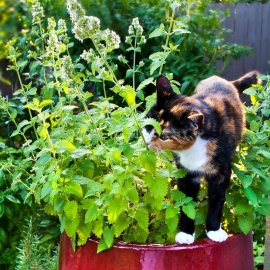




«Murka» - Organic Catnip Seeds
1.14 €
Not just for cats! Tall pink and white flower spikes are great in fresh and dried arrangements. Use the leaves in salads, sauces, teas, and soups – and of course fresh or dried for the cats! Catnip seeds are a good choice for a bee attractor.
-
Organic Catnip «Murka»
Not just for cats! Tall pink and white flower spikes are great in fresh and dried arrangements. Use the leaves in salads, sauces, teas, and soups – and of course fresh or dried for the cats!
Catnip seeds are a good choice for a bee attractor that works well in containers on cat-free balconies. Protect seedlings from cats. Catnip (and a few of its close relatives) contain the compound nepetalactone, which is extremely attractive to domestic and wild cats. It has the same effect on leopards, lynxes, and tigers as it does on house cats. Roughly 33% of all cats do not respond to catnip, and the response is believed to be hereditary.
Bring in Bees (and Cats!) while Deterring Insect Pests!
How to Grow
Catnip can be planted in your garden either from seed or from plants. If you’re growing catnip from seed, you’ll need to properly prepare the seeds. Catnip seeds are tough and need to be stratified or slightly damaged before they will sprout. This can be done by first placing the seeds in the freezer overnight and then placing the seeds in a bowl of water for 24 hours.
This process will damage the seed coat and will make it much easier for the catnip seeds to sprout. After you have stratified the seeds, you can plant them indoors or outdoors. Thin them to one plant per 20 inches after the sprout. You can also plant catnip from plant divisions or started plants. The best time for planting catnip starts or divisions is in either the spring or fall. Catnip plants should be planted 18 to 20 inches apart.
Catnip herb grows best in well draining soil in the full sun, but will tolerate part sun and a wide variety of soil types. Once catnip plants are established, they need very little in the way of care. They don’t need to be fertilized, as fertilizer can decrease the potency of their smell and flavor.
They only need to be provided with water beyond rainfall if you are growing catnip in pots or if you are having drought conditions. Catnip can become invasive in some areas so you need to take steps to control it. Catnip plants spread readily by seed so in order to control its spread, you’ll need to remove the flowers before they go to seed. Growing catnip can be rewarding. Now that you know a few facts about how to grow catnip, you (and your cat) can enjoy this wonderful herb.
